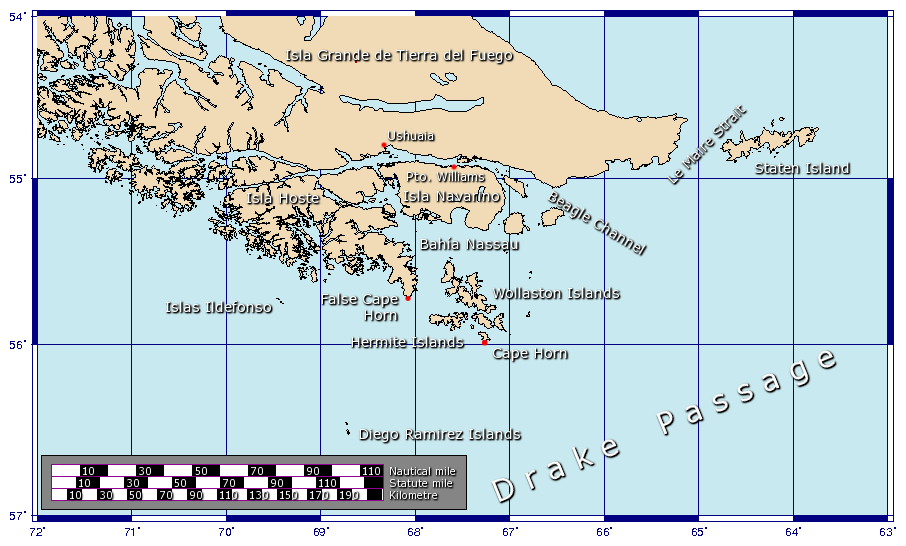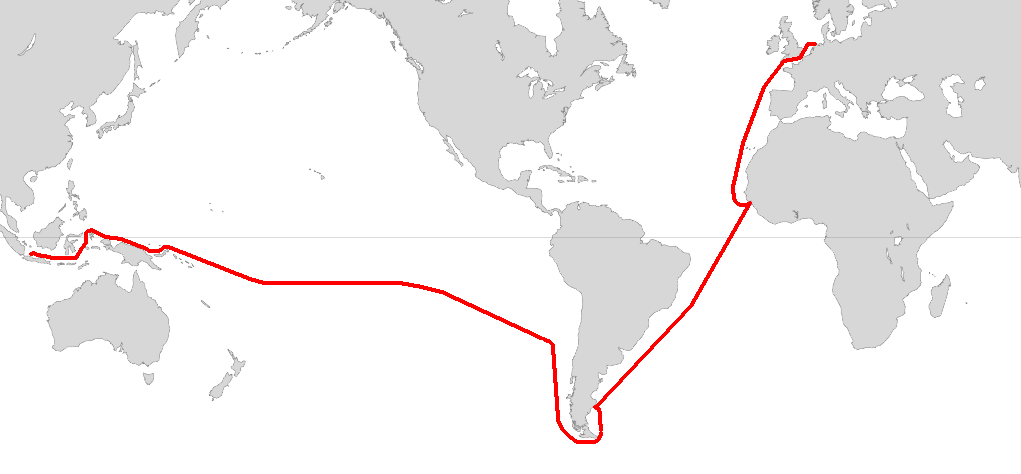|
Le Maire Strait
The Le Maire Strait (; ), also known as the Straits Lemaire, is a strait between Isla de los Estados ("Staten Island") and the eastern extremity of the Argentine portion of Tierra del Fuego. History Jacob Le Maire and Willem Schouten discovered the strait in 1616, while attempting to find a navigation link between the Atlantic and Pacific Oceans, shortly before their discovery of Cape Horn. The strait was named in honor of Le Maire. The Le Maire Strait has been Argentine controlled, but has been a historical access route for Chilean vessels, under international maritime law. The stormy weather and strong currents that the waters around Cape Horn are so famous for also affect the strait. To avoid the risk of being blown against the shore of Tierra del Fuego, sailing ships often instead favour going around to the east of Isla de los Estados. The Magellanic penguin is found in the Le Maire Strait; this penguin has a breeding colony on Isla de los Estados, the location of one of ... [...More Info...] [...Related Items...] OR: [Wikipedia] [Google] [Baidu] |
Pacific Ocean
The Pacific Ocean is the largest and deepest of Earth's five Borders of the oceans, oceanic divisions. It extends from the Arctic Ocean in the north to the Southern Ocean, or, depending on the definition, to Antarctica in the south, and is bounded by the continents of Asia and Australia in the west and the Americas in the east. At in area (as defined with a southern Antarctic border), the Pacific Ocean is the largest division of the World Ocean and the hydrosphere and covers approximately 46% of Earth's water surface and about 32% of the planet's total surface area, larger than its entire land area ().Pacific Ocean . ''Encyclopædia Britannica, Britannica Concise.'' 2008: Encyclopædia Britannica, Inc. The centers of both the Land and water hemispheres, water hemisphere and the Western Hemisphere, as well as the Pole of inaccessi ... [...More Info...] [...Related Items...] OR: [Wikipedia] [Google] [Baidu] |
Landforms Of Tierra Del Fuego Province, Argentina
A landform is a land feature on the solid surface of the Earth or other planetary body. They may be natural or may be anthropogenic (caused or influenced by human activity). Landforms together make up a given terrain, and their arrangement in the landscape is known as topography. Landforms include hills, mountains, canyons, and valleys, as well as shoreline features such as bays, peninsulas, and seas, including submerged features such as mid-ocean ridges, volcanoes, and the great oceanic basins. Physical characteristics Landforms are categorized by characteristic physical attributes such as elevation, slope, orientation, structure stratification, rock exposure, and soil type. Gross physical features or landforms include intuitive elements such as berms, cliffs, hills, mounds, peninsulas, ridges, rivers, valleys, volcanoes, and numerous other structural and size-scaled (e.g. ponds vs. lakes, hills vs. mountains) elements including various kinds of inland and oceanic waterbodi ... [...More Info...] [...Related Items...] OR: [Wikipedia] [Google] [Baidu] |
Bird Colony
A bird colony is a large congregation of individuals of one or more species of bird that nest or roost in proximity at a particular location. Many kinds of birds are known to congregate in groups of varying size; a congregation of nesting birds is called a breeding colony. Colonial nesting birds include seabirds such as auks and albatrosses; wetland species such as herons; and a few passerines such as weaverbirds, certain blackbirds, and some swallows. A group of birds congregating for rest is called a communal roost. Evidence of colonial nesting has been found in non- neornithine birds (Enantiornithes), in sediments from the Late Cretaceous (Maastrichtian) of Romania. Variations on colonial nesting in birds Approximately 13% of all bird species nest colonially. Nesting colonies are very common among seabirds on cliffs and islands. Nearly 95% of seabirds are colonial, leading to the usage, seabird colony, sometimes called a rookery. Many species of terns nest in colonies ... [...More Info...] [...Related Items...] OR: [Wikipedia] [Google] [Baidu] |
Magellanic Penguin
The Magellanic penguin (''Spheniscus magellanicus'') is a South American penguin, breeding in coastal Patagonia, including Argentina, Chile, and the Falkland Islands, with some bird migration, migrating to Brazil and Uruguay, where they are occasionally seen as far north as Espírito Santo. Vagrants have been found in El Salvador, the Avian Island in Antarctica, Australia, and New Zealand. It is the most numerous of the ''Spheniscus'' banded penguins. Its nearest relatives are the African penguin, the Humboldt penguin, and the Galápagos penguins. The Magellanic penguin was named after Portuguese explorer Ferdinand Magellan, who spotted the birds in 1520. The species is listed as being of Least Concern by the IUCN. Description Magellanic penguins are medium-sized penguins which grow to be tall and weigh between . The males are larger than the females, and the weight of both drops while the parents raise their young. Adults have black backs and white abdomens. There are two b ... [...More Info...] [...Related Items...] OR: [Wikipedia] [Google] [Baidu] |
Maritime Law
Maritime law or admiralty law is a body of law that governs nautical issues and private maritime disputes. Admiralty law consists of both domestic law on maritime activities, and private international law governing the relationships between private parties operating or using ocean-going ships. While each legal jurisdiction usually has its own legislation governing maritime matters, the international nature of the topic and the need for uniformity has, since 1900, led to considerable international maritime law developments, including numerous multilateral treaties. Admiralty law, which mainly governs the relations of private parties, is distinguished from the law of the sea, a body of public international law regulating maritime relationships between nations, such as navigational rights, mineral rights, and jurisdiction over coastal waters. While admiralty law is adjudicated in national courts, the United Nations Convention on the Law of the Sea has been adopted by 167 countrie ... [...More Info...] [...Related Items...] OR: [Wikipedia] [Google] [Baidu] |
Cape Horn
Cape Horn (, ) is the southernmost headland of the Tierra del Fuego archipelago of southern Chile, and is located on the small Hornos Island. Although not the most southerly point of South America (which is Águila Islet), Cape Horn marks the northern boundary of the Drake Passage and marks where the Atlantic and Pacific Oceans meet. Cape Horn was identified by mariners and first rounded in 1616 by the Dutchmen Willem Schouten and Jacob Le Maire, who named it after the city of Hoorn in the Netherlands. For decades, Cape Horn was a major milestone on the clipper route, by which sailing ships carried trade around the world. The waters around Cape Horn are particularly hazardous, owing to strong winds, large waves, strong currents and icebergs. The need for boats and ships to round Cape Horn was greatly reduced by the opening of the Panama Canal in August 1914. Sailing around Cape Horn is still widely regarded as one of the major challenges in yachting. Thus, a few recreational ... [...More Info...] [...Related Items...] OR: [Wikipedia] [Google] [Baidu] |
Atlantic Ocean
The Atlantic Ocean is the second largest of the world's five borders of the oceans, oceanic divisions, with an area of about . It covers approximately 17% of Earth#Surface, Earth's surface and about 24% of its water surface area. During the Age of Discovery, it was known for separating the New World of the Americas (North America and South America) from the Old World of Afro-Eurasia (Africa, Asia, and Europe). Through its separation of Afro-Eurasia from the Americas, the Atlantic Ocean has played a central role in the development of human society, globalization, and the histories of many nations. While the Norse colonization of North America, Norse were the first known humans to cross the Atlantic, it was the expedition of Christopher Columbus in 1492 that proved to be the most consequential. Columbus's expedition ushered in an Age of Discovery, age of exploration and colonization of the Americas by European powers, most notably Portuguese Empire, Portugal, Spanish Empire, Sp ... [...More Info...] [...Related Items...] OR: [Wikipedia] [Google] [Baidu] |
Willem Schouten
Willem Cornelisz Schouten (1625) was a Dutch navigator for the Dutch East India Company. He was the first to sail the Cape Horn route to the Pacific Ocean. Biography Willem Cornelisz Schouten was born around 1567 in Hoorn, Holland, Seventeen Provinces. In April 1601 Willem Schouten was skipper of the Duyfken in the 'Moluccan fleet' of Wolfert Hermansz, and participated in the Battle of Bantam. On 1 July 1615 Willem Schouten and his younger brother Jan Schouten sailed from Texel in the Netherlands, in an expedition led by Jacob Le Maire and sponsored by Isaac Le Maire and his in equal shares with Schouten. The expedition consisted of two ships: ''Eendracht'' and ''Hoorn''.Quanchi, ''Historical Dictionary of the Discovery and Exploration of the Pacific Islands'', pp. 222–33 A main purpose of the voyage was to search for . A further objective was to explore a western route to the Pacific Ocean to evade the trade restrictions of the Dutch East India Company (VOC) i ... [...More Info...] [...Related Items...] OR: [Wikipedia] [Google] [Baidu] |
Jacob Le Maire
Jacob Le Maire (c. 1585 – 22 December 1616) was a Dutch mariner who circumnavigated the Earth in 1615 and 1616. The strait between Tierra del Fuego and Isla de los Estados was named the Le Maire Strait in his honour, though not without controversy. It was Le Maire himself who proposed to the council aboard ''Eendracht'' that the new passage should be called by his name and the council unanimously agreed with Le Maire. The author or authors of ''The Relation'' took ''Eendracht'' captain Willem Schouten's side by proclaiming: :“ ... our men had each of them three cups of wine in signe of ioy for our good hap ... nd the naming ofthe ''Straights of Le Maire'', although by good right it should rather have been called ''Willem Schouten Straight'', after our Masters Name, by whose wise conduction and skill in sayling, the same was found.”. ''Eendracht'' then rounded Cape Horn, proving that Tierra del Fuego was not a continent. Biography Jacob Le Maire was born in either Antwer ... [...More Info...] [...Related Items...] OR: [Wikipedia] [Google] [Baidu] |




